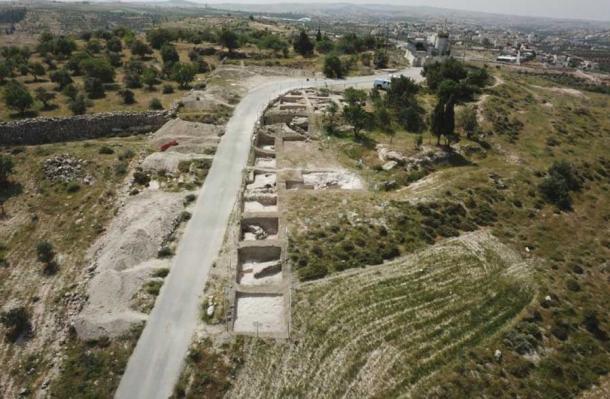Hanukkah or the Jewish Festival of Lights is celebrated in memory of the recovery of the Second Temple in Jerusalem from the Seleucid Empire in the 2nd century BC. This was at the beginning of the Maccabean revolt against Seleucid Hellenistic influences and persecution. Now, a newly discovered Seleucid sling stone from nearly 2,300 years ago sheds more light on the violence and bloodshed that are all central themes in the Hanukkah story. Hanukkah 2021 is currently being celebrated over a period of eight days (always somewhere in November or December, depending on the year) all over Israel and beyond.

The Seleucid sling stone was unearthed at the Zif archaeological site in the South Hebron Hills of Israel, which was a location for battles against the Maccabees rebels of Judea in the second century BC. ( COGAT)
Stories in the Seleucid Sling Stone and Charred Fortress
The newly discovered Seleucid sling stone features the name of Diodotus Tryphon , the ancient Greek king who ruled the Seleucids between 142 and 138 BC.
The 3-cm or 1.2-inch-long lead projectile also features a symbol of Zeus , the Greek uber god. The discovery was made at Zif, an archaeological site in the South Hebron Hills, this past Sunday. It was discovered by the archaeological section of the Coordination of Government Activities in the Territories (COGAT) .
The Seleucid Greek king Diodotus Tryphon occupies a notorious place in Jewish history. His forces killed Jonathan Maccabee , younger brother of Judah and son of Mattathias Maccabee. Mattathias Maccabee became the leader of the Maccabee dynasty and the initial revolt period in the second century BC. Jonathan was slated to be the next High Priest of Judea , and his death sparked a fierce rebellious response from the Maccabees against the Seleucids.
This year, only two weeks ago, the charred remains of a 2,100 year old Hellenistic fortress burnt down by the Maccabees in the years preceding the final revolt, was found in Israel. The fort had belonged to Greek soldiers of the Seleucid Empire and was burnt down by the Judean Hasmonean dynasty that would take over Jerusalem until 67 BC. Weapons, charred wooden beams, and dozens of coins were also found at the site, shedding more light on the “Hannukah story” and the fierce fighting spirit of the Jews just as the Seleucid sling stone has.
“We continue to discover new findings that add to the rich history that took place in the West Bank hundreds and thousands of years ago. The Civil Administration will continue to work tirelessly to preserve and expose the archaeological sites, and national heritage and cultural assets throughout Judea and Samaria,” said Civil Administration Archaeological Department officer Hananya Hizmi, Staff Officer of Archaeology in the area.

Philippe De Loutherbourg’s painting of Mattathias slaying the Jewish apostate in 167 BC, which was the beginning of the Maccabees revolt against Seleucid Hellenistic ideas and lifestyles. (Phillip Medhurst / FAL)
The Maccabean Revolt and The Movement for Independence
The Maccabees rebelled against the Seleucids primarily due to the undue influence and interference of the Hellenistic way of life on Jewish life.
The Seleucids, Greek Syrians by origin, established a Greek state in Western Asia between 312 BC and 63 BC, following the division of the Macedonian Empire, whose erstwhile founder was Alexander the Great. At this point in history, not only was the Hellenistic way of life an imposition, but also, Judaism was banned, causing mass discontent and anger amongst the Judean people.
The Seleucids faced an onslaught from the Maccabee Jews, in what was initially a guerrilla movement in the countryside, which involved frequent raids and harassment of Greek officials.
Eventually, the small successes and raids led to the development of proper armies that could take on fortified cities. This culminated in the recapture of Jerusalem in 164 BC after an 11-year war that resulted in the defeat of Seleucid Antiochus IV Epiphanes.
The subsequent cleansing of the Second Temple and rededication of the altar in Jerusalem is the official reason for celebrating Hannukah.
Historically, the revolt and its successes are seen as one of the first movements for Jewish nationalism and resisting the authority of a government engaged in Jewish suppression. But this was just the beginning of Jewish independence on a larger scale.
Though the Seleucids, rattled by the loss of Jerusalem, unbanned Judaism, the more radical Maccabees continued to organize and fight. And in a little over twenty years, despite the loss of loss of Judas Maccabeus in the Battle of Elasa, Simon Thassi led the Maccabees to autonomy from the Seleucid Empire in 140 BC.
Top image: The 3-cm or 1.2-inch lead Seleucid sling stone recently unearthed at the Zif South Hebron Hills archaeological site in Israel. Source: COGAT
By Sahir Pandey
Related posts:
Views: 0
 RSS Feed
RSS Feed

















 December 4th, 2021
December 4th, 2021  Awake Goy
Awake Goy  Posted in
Posted in  Tags:
Tags: 
















